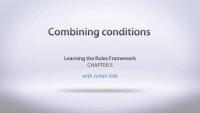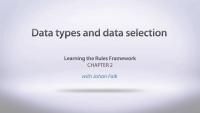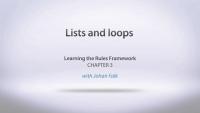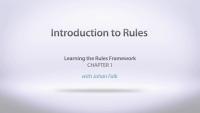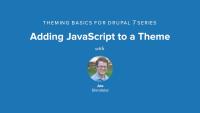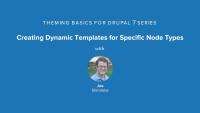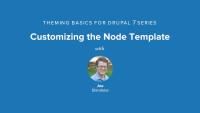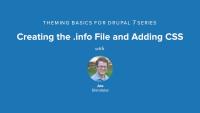Combining Conditions
FreeThis screencast explains how to use AND and OR groups in Rules to configure more complex conditions. This is demonstrated by creating a rule that notifies administrators when content is promoted to front page using an OR group. (The same procedure can be used to create an AND group.)
The screencast covers:
- How to combine conditions
- How to create an OR group
- Some advice about the order of conditions
- How to delete reaction rules
- Why you shouldn’t use the “send e-mail to all users in a role” action
- Why it might be useful to have messages printed out when configuring complex rules
Additional resources
Rules guide (Drupal.org)
This tutorial guides you on a quick safari through the actions, conditions and events provided by Rules core. It covers:
- A quick look at some actions provided by Rules
- A quick look at conditions provided by Rules
- A quick look at events provided by Rules
- Some words about data objects being provided to Rules by the triggering events
- Some words about multiple events in one rule limiting the available data (rather than expanding)
Additional resources
Rules guide (Drupal.org)
This tutorial presents data types and the data selection method for input in Rules. This is the most important difference between Rules 1 (D6) and Rules 2 (D7).
- How to use data selection to explore available data and drill down to selected properties
- Using the data comparison condition
- Using the set a data value action
- That Rules recognizes different types of data, and verifies when necessary
- That Rules knows that not all data is writable, and verifies when necessary
- How to create composite tokens, extending the tokens listed in the replacement patterns
- Making field values accessible to Rules
- Using reference fields to access new data, such as tags on an article or nodes in a node reference field
Additional resources
Rules guide (Drupal.org)
Learning the Rules Framework
CourseLists and Loops
FreeThis tutorial shows how to manage lists in Rules – data types corresponding to arrays of other data types. It covers:
- How to loop through multiple-value data in Rules, to act on each individual data entry
- That lists are their own data types in Rules
- That each primary data type automatically gets a list type as well
- How to add data to lists
- How to only add data if it is not already present
- How to select whether to add new data to the start or end of the list
- How to load new entities into Rules (by id)
- A few words about other ways of fetching entities, such as by property or with Views (through VBO or Rules Bonus Pack)
- That Rules configuration are actually entities
- How to disable reaction rules
Additional resources
Rules guide (Drupal.org)
This series on Learning the Rules framework was produced by Johan Falk of nodeone.se, and it will present some basic and advanced usage of the Rules framework.
The Rules module helps decrease the need for custom coding. Johan starts with an empty sandbox site. He enables the 3 related Rules modules, and the modules they depend on. Now, we see what it can do for our site by creating some reaction rules. This isn’t just an introduction – you actually get into the mechanics of using Rules right away.
Additional resources
- Rules module — Drupal.org
- Rules guide (Drupal.org)
Site Improvements with Daisyjo
Blog postAnother Drupalize.Me release, another pony. Our Daisyjo release touched lots of little bits and pieces of the site. We implemented a number of changes that many of you have been asking for, as well as adding some things that would let you get to know us a little better.

We Get Around
We just finished our Do It With Drupal conference in Brooklyn, NY. If you missed the event, or were there and missed some of the sessions (there were so many good ones to see), we'll have videos of ALL the sessions on Drupalize.Me in a few weeks. You'll need to be a subscriber to access the videos, so if you're not already, sign up today.
New Series: Theming Basics in Drupal 7
Blog postWe've just finished posting a new video series introducing you to Drupal Theming in Drupal 7. "Theming" describes the process of customizing the look and feel of your Drupal site, which involves working with Drupal's templating system at the basic level, and writing customized theming functions in PHP at the more advanced level.
New Free Community Videos
Blog postWe've added a new category to the site, called Community, and we've already added two new free videos to it, Applying a patch to a module and Creating a patch for a module. We got the idea for the new category from a question asked by Paul Johnson on Twitter, and set to work on getting some videos up about patching.
Provides an overview of what is covered in the Theming Basics series and gives a preview of what is yet to be covered within the Advanced Theming video.
Walks through the process of adding a screenshot to you theme so that it'll show up properly within the theme administration page, following the screenshot directions found on Drupal.org, and using the Skitch screenshot app (you can use whichever screenshot app you like).
Additional resources
Takes a tour through some of the more useful template variables, and more ways of determining the available variables by adding the following code to a page template:
Walks through the process of first adding the search block to the node template file, and then explains some of the best practices for incorporating JavaScript scripts within your theme. Walks through how to protect the dollar-sign variable, and how to use the Drupal behaviors instead of the document ready so that your JavaScript will fire not only on page loads, but also if there is any dynamic material being loaded on the page through asynchronous page loads. We'll show you how to select the jQuery selector to target the desired element, and how to conform to Drupal's best-practice coding standards when it comes to integrating JavaScript and jQuery into your theme. You can learn more about jQuery itself with the Introduction to jQuery Series.
To use Query in no conflict mode, because was not defined.
Add this line on the top: jQuery.noConflict(); more info here: http://api.jquery.com/jQuery.noConflict/
To improve how the search box looks, you need to modify the following:
currently : search-theme-form
modify to: search-block-form
and then in the property in line 321 to look like this:
/* Header quick search */
#header form#search-block-form {
top: -165px;
Additional resources
Walks through the process of enabling the theme developer module and showing the themer info, which is like Firebug for Drupal theming. You can choose specific elements on the page to see what Drupal template files or theme functions were involved with outputting it to the screen. You can easily look at the candidate template names that are available, as well as see all of the variables that are available from that template file. A list of documented variables can be found within the node module's node.tpl.php file, but sometimes there are undocumented variables that are coming from contributed modules or elsewhere. It's a super handy tool to have available, but only enable it when you really need it since it can adversely affect the mark-up on your page and cause some wonky behavior.
Additional notes:
The Theme Developer module is on Drupal.org at http://drupal.org/project/devel_themer. Once you find a module on Drupal.org, you can see the "machine name" for the module in the URL (it is the same name as is used to for the module's .info file as well). That is the name that Drush uses. So, in this instance, Drush is looking for "devel_themer".
drush dl devel_themer
Additional resources
Shows how to create a theme template suggestion for a specific node type. In this chapter, we create a dynamic template for the article node type by copying the node.tpl.php into a node--article.tpl.php where the 'article' is the machine-readable name for the article content type. We add some specific styling to the node author submission information as well as the date. We also discuss how Drupal looks for the most specific template suggestion (i.e. the node id), then moves to more and more generalized template files like the content type, and then the node.tpl.php as the most general. The Drupal.org documentation page that we look at can be found at http://drupal.org/node/1089656.
Additional notes:
The field_tags variable relates to the corresponding tags field on the article content type. For every field you have on your node the $content variable will contain the rendered content of that node in a key that is the name of the field. So in this case $content['field_tags'] contains all of the tags applied to the node.
Additional resources
Walks through the process of copying the default node.tpl.php file from the core node module into the theme, and then customizing the output specific to individual in order to match the design. See how to add specific variables, when to use conditional if statements and the best way to debug and iterate through this process.
Additional resources
In this chapter, we add some sidebar and footer regions to the page via the .info files, and printing those new regions out in our page template file, adding some blocks to help with testing. We also talk about Devel and Krumo, and how we can use those to find out everything that is available in out page array, using the dsm() function. While inspecting out page array, we point out the differences between elements and properties within renderable arrays.
Additional resources
This video walks through the process of replacing static content in the page.tpl.php file with dynamic variables. Joe talks about the html.tpl.php file as well as pointing some of the important variables that should be included within the theme.
Additional resources
This chapter goes through the minimum steps for registering a theme within Drupal by creating a .info file. It also shows the syntax for a theme to be able to add custom CSS to your site as we start to implement our example design.
